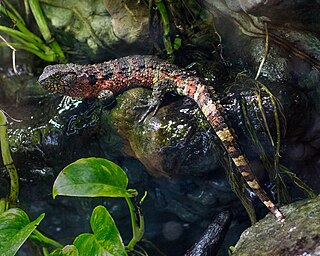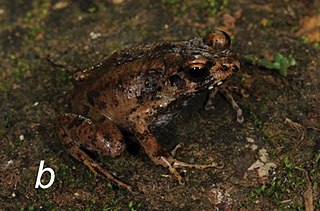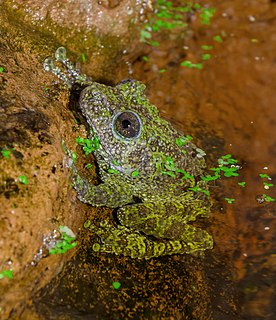
The Chinese crocodile lizard is a semiaquatic anguimorph lizard found only in cool forests in southeast China and northeast Vietnam. The Chinese crocodile lizard spends much of its time in shallow water or in overhanging branches and vegetation, where it hunts its prey of insects, snails, tadpoles, and worms. Individuals in captivity may be fed baby mice. A rare and little-studied lizard, it is listed in CITES Appendix I, which regulates international trade of specimens. This is the only species in the monotypic genus Shinisaurus. It is the only living member of the Shinisauria, a group of lizards whose fossil record extends back to the Early Cretaceous, over 120 million years ago.

Arthroleptis carquejai is a species of frog in the family Arthroleptidae. It is known with certainty only from north-western Angola, but there is also a recent record from Gabon. If this is correct, its distribution might also include intervening areas in the Republic of the Congo and the Democratic Republic of the Congo. The specific name carquejai honours Bento Carqueja, Portuguese professor, journalist, and philanthropist. The common names Cambondo screeching frog and Carqueja's squeaker have been proposed for it.
Hyla sanchiangensis is a species of frog in the family Hylidae. It is endemic to central and southern China and known from Fujian, Guangdong, Guangxi, Guizhou, Anhui, Zhejiang, Hunan, Hubei, and Jiangxi provinces. The type locality is "San Chiang" in what at present is the Wuyishan City. The type series was collected by Clifford H. Pope during the Third Asiatic Expedition of the American Museum of Natural History in 1926, and described in 1929, along with three other new amphibian species.
The spiny-fingered horned toad or spiny spadefoot toad, is a species of frog in the family Megophryidae. It is endemic to China and known from Sichuan, Yunnan, Guizhou, and Guangxi provinces. Its natural habitats are subtropical or tropical moist lowland forests, subtropical or tropical moist montane forests, and rivers. It is threatened by habitat loss.

Amolops ricketti is a species of frog in the family Ranidae that is found in southern and eastern China and northern and central montane Vietnam.
Quasipaa yei, or Ye's spiny-vented frog, is a species of frog in the family Dicroglossidae. It is endemic to China where it is known from the Dabie Mountains that straddle the border between Hubei, Henan, and Anhui provinces. Its type locality is in Shengcheng County in Jiyuan City, Henan. Its natural habitats are temperate rivers with surrounding forests. It is potentially threatened by habitat loss.
Quasipaa boulengeri is a species of frog in the family Dicroglossidae. It is known under many common names, including Boulenger's spiny frog, spiny-bellied frog, and Boulenger's paa frog. It is found in southern and southwestern China and northern Vietnam. It is a very common species that has declined. It is collected for human consumption, and it is also threatened by habitat loss. Its natural habitats are hill streams and ponds.

Quasipaa exilispinosa is a species of frog in the family Dicroglossidae. It is known under many common names, including Hong Kong spiny frog, common spiny frog, lesser spiny frog, little spiny frog, and Hong Kong paa frog. It has a patchy distribution in southern China including Hong Kong. Its natural habitats are subtropical hill streams in forests or shrublands, and sometimes also seepages, stream-fed marshes, and forests. It is threatened by over-collecting for human consumption and by habitat loss.
Quasipaa jiulongensis is a species of frog in the family Dicroglossidae. It is endemic to eastern China and only known from the mountains of southwestern Zhejiang and adjacent Fujian above 800 m (2,600 ft) elevation. Its natural habitats are hill streams. It is threatened by habitat loss due to both logging and infrastructure development as well as by collection for food.

Quasipaa spinosa is a species of frog in the family Dicroglossidae. It is known under many common names, including Chinese spiny frog, giant spiny frog, Chinese edible frog, and spiny paa frog. Its names refer to the distinctive characteristics of the species, relatively large size and the spiny chest of male frogs. Giant in frog terms only, it can nevertheless grow to lengths above 10 cm (4 in); this makes it the largest frog in Hong Kong.

Quasipaa verrucospinosa is a species of frog in the family Dicroglossidae. It is found in Laos, Vietnam, and Yunnan, China. It occurs in and around streams in hill and lower montane evergreen forests. It is believed to be relatively common, but it is threatened by collection for consumption and—presumably—habitat loss driven by logging, causing degradation of forest habitat and stream sedimentation.
Odorrana andersonii is a species of frog in the family Ranidae that is found in northeastern India, Upper Myanmar, southwestern China, northern Thailand, Laos, and Vietnam; records from Laos and Vietnam may refer to another species. They are found in low tree branches and on rocks along shaded rocky streams and large rivers with boulders, in evergreen forests and agricultural areas. Breeds takes place in streams.
Odorrana hainanensis is a species of frogs in the family Ranidae that might be endemic to Hainan Island, China; there is one record from Guangxi. Prior to its description in 2001, it was confused with Odorrana andersonii.
Odorrana hejiangensis is a species of frog in the family Ranidae that is endemic to China. It is found in the Yangtze River Valley of southern Chongqing and northern Guizhou, with an isolated record in western Guangxi. Its name refers to the type locality, Hejiang County in northern Sichuan. Its natural habitats are shaded hill streams and the surrounding riparian forests. Its status is insufficiently known.
Odorrana jingdongensis is a species of frogs in the family Ranidae. It is known from southern China and northern Vietnam, though it quite likely also occurs in the adjacent areas in Laos and in Myanmar. Its name refers to its type locality, Jingdong Yi Autonomous County in Yunnan. Common name Jingdong frog has been coined for it.
Odorrana lungshengensis is a species of frogs in the family Ranidae that is endemic to China. It is found in northeastern Guangxi, southwestern Hunan, and eastern Guizhou. Its natural habitats are hill streams in broad-leaf forests. It is becoming rare due to habitat loss.
Pseudophilautus zimmeri is an extinct species of frog in the family Rhacophoridae. It was endemic to Sri Lanka, where it was recorded from the vicinity of Galle. It is only known from the holotype that was used to describe the species in 1927. The specific name zimmeri honours Carl Wilhelm Erich Zimmer, a German zoologist. Common name Rumassala shrub frog has been coined for it.

Theloderma corticale is a species of frog in the family Rhacophoridae. It is found in northern Vietnam, south–central Laos, and southern China.

Quasipaa is a genus of frogs in the family Dicroglossidae. The genus has no established common name, but many individual species are referred to as spiny frogs. They occur in East and Southeast Asia, from Thailand and Cambodia to southern and eastern China.







